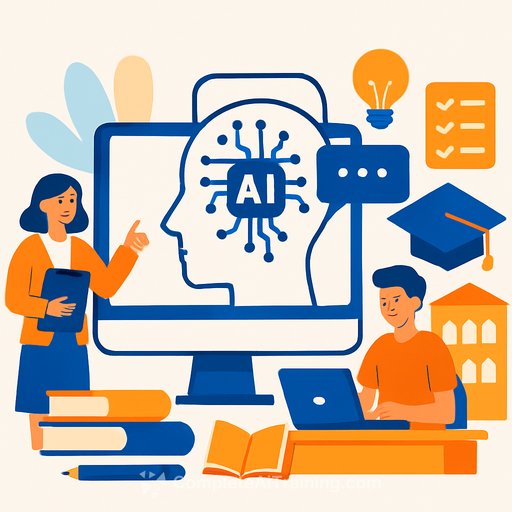Top 10 AI Prompts and Use Cases in the Education Industry in Chattanooga
Last Updated: August 15th, 2025
Education leaders in Chattanooga can adopt 10 key AI prompts and use cases to reduce administrative burden, optimize funding, and upskill staff. These include family engagement, student-growth analytics, early-warning systems, subgroup gap analysis, benchmarking, personalized professional development, attendance trend analysis, staffing allocation, communications, and ROI estimation.
K–12 and higher-education leaders in Chattanooga are actively applying AI to better align classrooms with Tennessee’s workforce needs. Initiatives such as the University of Tennessee's Work to Learn Tennessee program and local events like the Tennessee AI in Education & Workforce Development Conference support practical training for educators and district leaders.
For districts planning professional development or reskilling, short, applied programs provide a 15-week pathway to teach prompt engineering and workplace AI skills that connect directly to employer partnerships and local upskilling efforts.
Table of Contents
- Methodology - How prompts and use cases were selected
- Family Engagement + AI Awareness - Prompt: engage2learn family event ideas
- Analyze Student Growth and Identify Interventions - Prompt: Otus student growth analysis
- Early-warning / Predictive Identification - Prompt: SCORE early-warning risk scores
- Equity and Subgroup Gap Analysis - Prompt: subgroup achievement gaps
- Curriculum Alignment and Assessment Validation - Prompt: benchmark vs state comparison
- Teacher Effectiveness and PD Personalization - Prompt: PD by teacher growth
- Behavior & Attendance Trend Analysis - Prompt: chronic absenteeism patterns
- Staffing & Resource Allocation - Prompt: staffing suggestions from trends
- Communications and Morale - Prompt: communications plan for AI adoption
- ROI and Program Evaluation - Prompt: estimate ROI for interventions
- Conclusion - Next steps for Chattanooga education leaders
- Frequently Asked Questions
Methodology - How prompts and use cases were selected
The chosen prompts and use cases focus on immediate applicability for Tennessee districts. Selection criteria included alignment with state AI policies, budget realities specific to Chattanooga, and connections to workforce reskilling. Priority was given to examples that reduce operational workload and support compliance with district AI guidelines.
Family Engagement + AI Awareness - Prompt: engage2learn family event ideas
Create family engagement events that make AI approachable and hands-on. Use the engage2learn prompt to guide families through activities using ChatGPT, Gemini, Claude, or Perplexity. Offer simple stations where caregivers learn one effective prompting technique—Persona-Task-Context-Format—to design developmentally appropriate activities on the spot.
Analyze Student Growth and Identify Interventions - Prompt: Otus student growth analysis
Leverage AI to convert fragmented assessment snapshots into clear intervention lists. Centralizing data allows MTSS teams and special education staff to access historical and current progress plans in one place. This approach moves READ, 504, and ALP plans out of silos, adding year-over-year evidence for informed decisions.
Early-warning / Predictive Identification - Prompt: SCORE early-warning risk scores
Use AI to generate ranked lists of students by composite risk based on SCORE early-warning scores. This enables MTSS teams to quickly deploy tiered interventions and document their impact for school boards and families.
Equity and Subgroup Gap Analysis - Prompt: subgroup achievement gaps
AI can produce disaggregated reports highlighting achievement gaps among student subgroups. These insights make disparities visible to school leaders and directly inform targeted action plans.
Curriculum Alignment and Assessment Validation - Prompt: benchmark vs state comparison
Run AI-driven checks that compare benchmarks to state standards, flagging misaligned standards, unstable item performance, or unusual score changes. Curriculum teams receive a prioritized list of units and assessment items needing review.
Teacher Effectiveness and PD Personalization - Prompt: PD by teacher growth
Replace generic professional development workshops with AI-driven, personalized learning paths. Using classroom observations, student outcomes, and self-assessments, AI recommends adaptive modules focused on each teacher’s growth areas.
Behavior & Attendance Trend Analysis - Prompt: chronic absenteeism patterns
Analyze attendance logs, behavior incidents, and assessment trends through AI to identify students crossing risk thresholds. This enables early intervention for chronic absenteeism and related behavioral issues.
Staffing & Resource Allocation - Prompt: staffing suggestions from trends
Transform data trends into actionable staffing recommendations. AI can map operational savings and automation risks to specific roles, helping districts optimize staffing and resource allocation.
Communications and Morale - Prompt: communications plan for AI adoption
Approach AI adoption as a deliberate communications effort. Begin with low-risk automations, run short sandbox pilots for staff, and clearly disclose AI use on high-profile materials to maintain transparency and build trust.
ROI and Program Evaluation - Prompt: estimate ROI for interventions
Combine social service return on investment (SSROI) methods with conservative cost-benefit analysis using AI. This helps district leaders move beyond isolated pilots to budget-linked decisions grounded in measurable impact.
Conclusion - Next steps for Chattanooga education leaders
Leaders should transition from pilot projects to scaled, policy-aligned AI implementation. This includes adopting district AI policies consistent with Tennessee’s K–12 AI requirements and repurposing savings from low-risk automations into focused reskilling and assessment validation efforts.
Frequently Asked Questions
What are the top AI prompts and use cases for education leaders in Chattanooga?
This article outlines 10 actionable AI prompts and use cases customized for Chattanooga and Tennessee districts.
How were these prompts and use cases selected for Chattanooga districts?
They were chosen based on immediate relevance within Tennessee policy frameworks and local budget conditions.
How can districts pilot AI while staying compliant with Tennessee K–12 AI policy?
Start by adopting district AI policies aligned with state guidance, then implement low-risk operational pilots to build experience.
What practical training or programs are suggested for staff PD and reskilling?
Short, applied programs that teach prompt engineering and workplace AI skills provide effective pathways for upskilling.
How can districts convert AI-driven operational savings into measurable educational impact?
Savings from automation can be reinvested into high-impact work such as targeted reskilling and assessment validation.
For educators interested in AI training programs that fit into professional development plans, Complete AI Training offers relevant courses that cover prompt engineering and AI applications in the workplace.
Your membership also unlocks:





